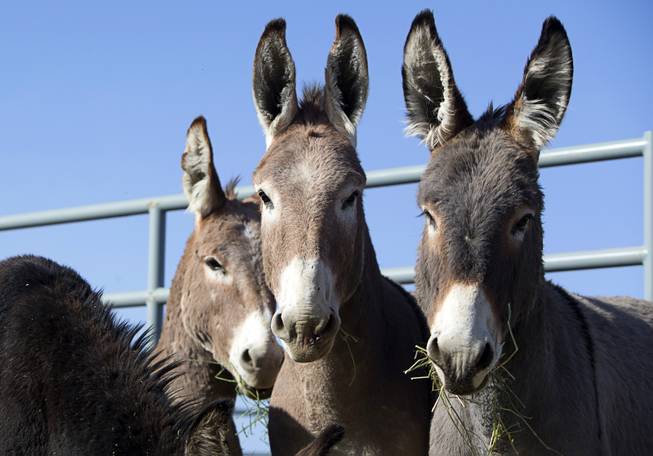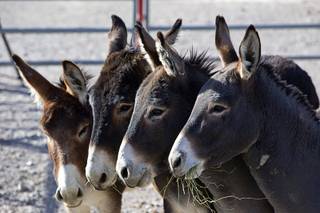
Burros are shown in a holding corral near U.S. 95 and Highway 160 during a Bureau of Land Management burro gather Wednesday, Dec. 20, 2017. So far, the BLM has gathered 39 feral burros. The gather was prompted by an increasing number of accidents involving burros and vehicles near Pahrump and also to burros causing private property damage, officials said.
Monday, Jan. 22, 2018 | 2 a.m.
Burros as working animals
Originally brought to the American West by miners, burros are still used by hunters to carry goods and supplies. They are also surprisingly good candidates for emotional therapy — Romero says she prefers bringing burros over horses to public events because they’re typically more comfortable with being petted and touched.
Burros also can be a good line of defense from coyotes.
“They are good guard animals,” Romero said. “A horse is fright and flight. If they think they might be hurt, they take off. Burros are more willing to stand their ground. They will chase off (coyotes).”
Did you know?
• As of March 2016, Nevada rangeland was home to 2,552 burros.
• A single burro can cost taxpayers up to $50,000 over its lifetime if maintained in a BLM facility.
• 3,320 horses and burros were removed from the range across multiple states and taken to BLM holding facilities during the 2016 fiscal year, compared with 8,255 in fiscal year 2012. According to the BLM, removals have decreased because “resources are inadequate to care for more unplaced animals.”
• The budget for the BLM’s Wild Horse and Burro Program across the 10 Western states is $78.29 million. Almost $50 million, or 63 percent of all funding, goes to the cost of holding animals off-range.
• There have been more than 235,000 wild horses and burros adopted nationwide since 1971. In fiscal year 2016, 2,440 horses and 472 burros removed from the Western rangeland were adopted.
Wild burros are not the problem. It’s the people feeding them.
That’s essentially the message the Bureau of Land Management has for anyone who thinks it’s a good idea to put out water and food for wild burros: The act of kindness is causing more harm than good in Nye County.
“It’s always a good intention,” says Tabitha Romero, BLM wild horse and burro specialist. “But the end result, most of the time, isn’t good.”
Lured by the promise of an easy meal, burros have been wandering from their designated herd area on BLM land, colliding with fast-traveling vehicles on Nevada State Route 160 and wreaking havoc on neighborhoods in northwest Pahrump. The issue was deemed serious enough to prompt the roundup and removal of 117 burros from private property and was done during a two-week period in December.
“Most people only have a passing interest in the issue,” Romero said. “Since we have domesticated them for so long, we almost don’t see them as a wild animal. We go, ‘Oh, what a cute little donkey.’ But they are wild animals. They can cause serious damage.”
During a 13-month timespan, there were at least 22 collisions involving vehicles and burros on State Route 160. At least one person was injured enough to require an airlift to a hospital. Additional incidents likely have occurred but were not reported to authorities, officials say.
When the burros cross the highway, they can cause property damage to fences, yards and irrigation systems. One family reported being charged by a male burro as they tried to shoo him off their property. Incidents like that, in addition to collisions with cars, prompted the nuisance gather.
“We have to prioritize health and human safety,” BLM spokesman John Asselin said. “It was a safety issue for humans in neighborhoods, and also for the health of the animals.”
While wild horse gathers can be controversial productions that involve helicopters, burro gathers are far less dramatic. BLM officials use food and water to bait the animals into a fenced area and a remote control to close the gate behind them.
“Burros are inherently lazy,” Romero said. “If they can get a handout, they’ll go for the handout.”
The burros gathered in Nye County were part of Johnnie Herd Management Area, which is composed of 2,000 acres of BLM land on the other side of the highway. Post-gather, that herd management area is still home to more than 200 burros — more than double what the BLM deems is acceptable for the natural resources.
All but one of the 117 burros gathered were transferred to the Ridgecrest Regional Wild Horse and Burro Corrals, a short-term holding facility in Ridgecrest, Calif. There, the animals will receive a veterinary checkup, vaccines, hoof trims and markings. Males will be gelded.
One, an elderly female, was euthanized because her body was “in poor condition,” Romero said.
The BLM will typically give a burro three to six years to be adopted through its program. If they aren’t adopted, they will be transferred to a long-term pasture in the Midwest, where they can live out the rest of their lives.
Wild burros and horses have been protected by the federal government since the 1971 passage of the Wild Free-Roaming Horses and Burros Act. Mass euthanasia is allowed but the option has never been exercised, largely because of overwhelming public opposition.
Tens of thousands of wild horses and burros from 10 Western states are in the care of the BLM. The cost of maintaining these animals is upward of $50 million annually.

